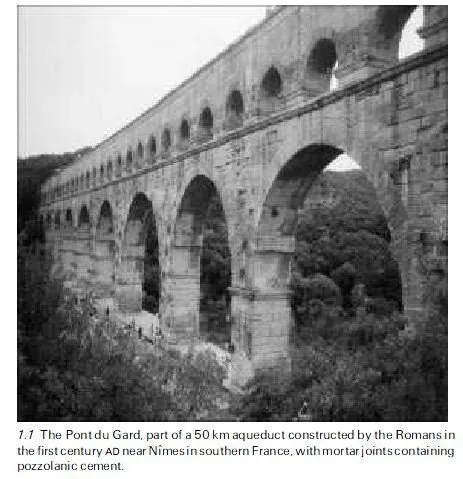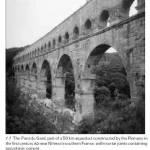The purpose of this book is to bring together a series of reviews on topics of current relevance to the durability of concrete and cement-based composites. One might reasonably ask why such a book is now believed to be needed as concrete and related materials have been used with outstanding success in major construction projects for well over two thousand years. Indeed numerous ancient concrete structures, such as the Pantheon in Rome, and masonry structures with mortar joints, such as the Pont du Gard Aqueduct near NõÃmes in southern France (see Fig. 1.1), have survived to the present day in excellent states of preserva- tion. These and other examples of Roman construction works incorporating hydraulic cements made from lime and volcanic earth (or similar vitrified alumino-silicates, known collectively as pozzolanas, after Pozzuoli near Naples where a natural source of such material exists) have shown remarkable dur- ability even where they have been exposed to damp, aggressive environments. An impressive illustration was provided by Davey (1974) whose photograph of part of a Roman breakwater that had been exposed to the sea near Naples for two millennia (reproduced in Fig. 1.2), demonstrates that the mortar joints had endured far more successfully than the now heavily eroded stone blocks which they had been connecting.
Whilst the Romans had probably discovered the art of producing durable pozzolanic hydraulic cements by the end of the third century BC, the com- positional features and properties of these materials appear to have remained largely unexplored until about 250 years ago when John Smeaton (see Fig. 1.3), the first Englishman to describe himself as a civil engineer, carried out systematic investigations into the behaviour of mortars incorporating limes and pozzolanas from various sources. This work, performed with the practical objective of selecting an appropriately durable blend of pozzolanic cement for use in the construction of the Eddystone Lighthouse (1756±59), produced important findings that were eventually published (Smeaton, 1791) and this paved the way for a number of advances in the development of hydraulic cement binders over the next half century or so. The most significant of these advances was the invention of `Portland cement’, produced by heating together mixtures of calcareous (lime-based) and argillaceous (clay-based) substances at suitably high temperatures. A synthetic cement of this name was patented in 1824, exactly a century after Smeaton’s birth, by another former inhabitant of Leeds, Joseph Aspdin, whose contribution (like Smeaton’s) is commemorated by a blue plaque on one of the city’s buildings (see Fig. 1.4).

Fitting testimony to the durability of Aspdin’s product is provided in Fig. 1.5, which shows a mortar statuette depicting `The Prophet Samuel in Infancy’, thought to have been made circa 1850 by James Aspdin, Joseph’s elder son. The statuette was brought to light in 1974, standing in the Yorkshire garden of a great- great niece of Joseph Aspdin. It had apparently been exposed to the vagaries of the weather for well over a century and was found covered with moss and lichen. Further details of the statuette’s provenance are given in a note by Barfoot (1975), which supplements a longer article by the same author, relating the story of Joseph Aspdin and his two sons, James and William, both of whom also played a part in the early development of the cement industry (Barfoot, 1974).
Aspdin’s original 1824 version of `Portland cement’ is now thought to have been fired at temperatures too low to have induced effective vitrification of the constituents and the development of mass-produced cements of consistent quality therefore required several further technological advances to be made (Blezzard, 1998). By the latter part of the 19th century, however, reliable Portland cements with mineralogical features that were more similar to those of present-day varieties of the material were becoming widely available and this led to massive expansion in the use of concrete for many of the major infrastructure developments of the Victorian era in Britain. Once again, it is apparent from the number of structures of this period that have survived to the present day that the durability of Portland cement concrete can be remarkably good, as exemplified by the excellent condition of the Glenfinnan Viaduct, built in Scotland in 1897 by Robert McAlpine as part of the Fort William to Mallaig extension of the West Highland Railway (see Fig. 1.6).
In comparison with the example shown in Fig. 1.6, it must be admitted that some of our more modern structures have aged rather less gracefully and, on the basis of contemporary press reports (see Fig. 1.7), one might reasonably con- clude that the construction industry, in recent times, had not entirely mastered the art of creating durable and sustainable products from cement-based materials. As a generalisation, however, this is somewhat harsh because the vast majority of such products of the 20th century have not actually shown signs of premature degradation in spite of the fact that, at no previous time in history, has the industry been forced to adapt so rapidly to the pressures of change arising from a great variety of causes. What was until quite recently an activity relying on the availability of suitable local materials and labour, employing well-established craft-based practices, has been radically transformed in many parts of the world over a period of just a few decades. Not only has this led to significant changes in compositional features and properties of many of the constituents of the family of materials we call concrete and cement composites, it has also revolutionised the range of fabrication methods applied to them and thereby greatly extended their range of applications. World production of cement is continuing to grow at a significant rate and had already amounted to some 1.9 billion tonnes p.a. by 2003, representing an average annual usage of concrete of nearly 1m3 per person. Little wonder then that when something does go wrong, it can go wrong on a scale large enough to produce headlines of the sort illustrated in Fig. 1.7.
Since the pressures that have driven innovation throughout the last century are now increasingly acute, there is every reason to think that the 21st century will present even greater challenges for those involved in the applications of concrete and cement composites. The need to create sustainable construction products that are expected to fulfil their intended functions, remaining in serviceable condition for very long periods with only minimal maintenance before being recycled efficiently, will lead to many changes in current practices. This will inevitably raise questions regarding the durability issues concerned because, in the absence of adequate prior experience of relevant long-term performance, it becomes increasingly difficult to continue to justify the prescriptive `deemed-to-satisfy’ approach towards specifying durability that has been a feature of traditional codes and standards. The holy grail of much of the durability-related research conducted over the past twenty years or so, has therefore been to provide the underpinning theory needed to allow the development of quantitative models of degradation phenomena that may lead in turn to new methods of durability design for structures and components exposed to stated environmental actions for specified intended service lives. To become generally acceptable, these new design methods must be firmly supported by scientific principles that will allow materials selection to be made on the basis of performance testing, rather than by prescription, and the performance tests concerned need to satisfy appropriate criteria of convenience, reliability, and precision. The approach clearly has much to offer as a means of enabling fair comparisons to be made between competitor materials and thus of promoting technical innovation of a kind that is becoming increasingly urgent. While considerable progress has been made in the above-mentioned areas, with international organisations such as RILEM playing an influential role, it must be noted that the way forward has been far from easy for a variety of reasons which will become apparent in several of the chapters of this book. One of the major difficulties has undoubtedly been the continuing uncertainty over key microstructural features of cement-based materials that affect the development and continuity of the pores of different size ranges within them. These features in turn influence the evolution of the resistance of the materials to the processes of mass transport that are involved in degradation phenomena of different kinds. This has been an area of intensive debate amongst researchers ever since the classic investigations carried out at the laboratories of the Portland Cement Association were published more than half a century ago (Powers and Brownyard, 1948). Equally, and in spite of the important development during the early 1970s of a viable method for extracting samples of the liquid phase associated with hardened cements and related materials (Longuet et al., 1973), it has proved to be difficult to resolve fully the compositional features of the aqueous solution phase residing within sub-surface pores of different forms of concrete subjected to various conditions of exposure. This has also presented a considerable barrier to understanding of many of the most important degradation phenomena that affect these materials. The following chapter of this book therefore presents a state-of-the-art review of the pore structure and pore solution chemistry of cement-based materials, setting the scene for subsequent chapters that deal with major specific forms of degradation to which concrete and cement composites are potentially vulnerable. It should be made quite clear, however, that we do not attempt to suggest that the book can provide a comprehensive treatment of this vast subject area. There are some omissions of which we are aware, and no doubt others of which we are not, but we hope that the work as a whole will prove helpful to those who require a reasonably detailed treatment of some of the many facets of the durability of the world’s most widely used man-made materials. Finally, we would like to acknowledge the fact that a book of this kind could not have been produced without the sustained efforts of many busy individuals who were cajoled into writing chapters when more immediately pressing demands were being made on their time. We are grateful to all of them for their contributions to the work and to the publishers for their patience in dealing with the delays that inevitably seem to crop up with undertakings such as this.



